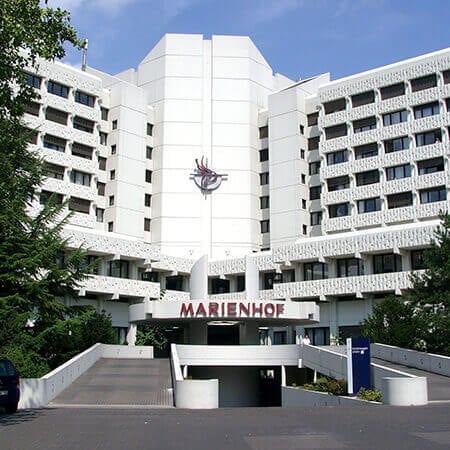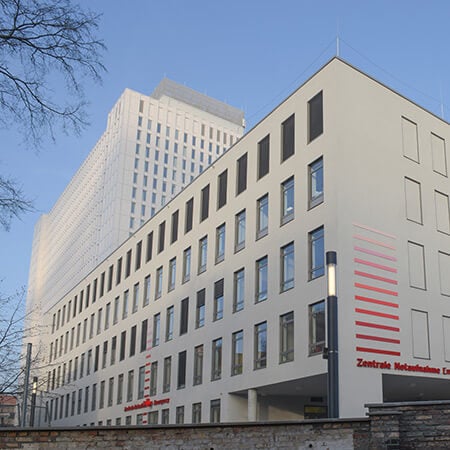The spinal cord is an important organ responsible for hematopoiesis (blood cell production). It is responsible for maintaining white blood cell count, which means that it is responsible for the body's immune system. Spinal cord cancer is a serious health condition that affects the central nervous system. Patients often perceive it as a sentence. However, the level of modern medicine makes it possible not only to slow down the disease, but in some cases to get rid of spinal tumors completely.
Content
- Classification
- Symptoms of the spinal cord malignant tumor
- Risk factors for the development of the spinal cord malignant tumor
- How is spinal cord malignant tumor diagnosed?
- What are treatment options?
- Surgery
- Prognosis
- Treatment in European hospitals
- Cost of treatment
- Treatment with Booking Health
Classification
There are several types of spinal cord cancer, depending on its origin, localization, and stage.
Thus, according to the place of origin of the primary neoplasm, a distinction between primary spinal cord cancer and secondary is made. With primary spinal tumors, malignant cells form directly in the spinal cord and in its structures, whereas secondary spinal tumors occur due to metastasis from other organs (prostate gland, gastrointestinal tract, lungs, breast, thyroid gland, etc.) to the spinal cord.
According to the localization, spinal cord cancer can be:
- Extramedullary (make up to 80% of all cases of spinal tumors) spinal tumors do not sprout directly into the spinal cord, but cluster near it.
- Intramedullary (about 20 % of all cases) spinal tumors develop directly in the spinal cord.
Spinal tumors may be formed in different parts of the spinal column, which affects the manifestations of spinal cord cancer. According to this principle, cervical, lumbosacral, thoracic, cauda equina, medullary cone tumors are distinguished.
In terms of stages of spinal cord cancer, the first stage can last a long time (sometimes 10 – 15 years). The patient's health condition is characterized by muscle weakness, discomfort when bending, sensitivity disorders, and episodic back pain. Patients usually do not pay attention to these symptoms and do not suspect that they may indicate cancer.
The second stage of spinal cord cancer occurs when tumors increase in size. This causes worsening of sensory dysfunction, increased pain, and partial paralysis of the legs. In some cases, spinal cord cancer skips the second stage and immediately enters the terminal one.
The third stage of spinal cord cancer is characterized by motor and sensory disorders, as well as pelvic dysfunction. The pain syndrome increases. Limbs are paralyzed, either one or both. After three months, the symptoms reach their peak and full paralysis sets in. The entire third stage lasts about six months.
Manifestation varies according to the duration of spinal cord cancer. In the early stages, the spinal tumor almost doesn’t manifest itself much. Most of the symptoms of spinal cord cancer are found in the second and third stages, and they differ depending on the type of tumors and their localization.
Spinal cord malignant tumor is an abnormal cancerous growth in the spinal cord or around it.
Treatment includes surgery, radiation therapy, chemotherapy, symptomatic treatment.
Cost of microsurgical removal starts from €8,697. You can find prices for other therapeutic options on the Booking Health website.
The best hospitals in Europe are:
- University Hospital of Ludwig Maximilian University of Munich
- University Hospital Rechts der Isar Munich
- University Hospital Frankfurt-am-Main
- Clinic of Advanced Biological Medicine Frankfurt-am-Main
- Helios Hospital Berlin-Buch
Symptoms of the spinal cord malignant tumor
The main symptoms of the spinal cord tumors in the early stages include:
- Reduced performance, fatigue, drowsiness, and nausea.
- Pain in the back and limbs.
- Problems with coordination.
- Changing sensations in the legs (tingling, numbness, muscle twitching, hot or cold flashes).
- Skin allergic reactions.
- Genitourinary problems, including decreased libido.
Later, these symptoms of spinal cord cancer worsen, and the new signs appear:
- Loss of sensitivity in different parts of the body.
- Problems with swallowing and speech.
- Paralysis (often the complete one).
- Urinary and fecal incontinence.
- Impaired cardiac activity.
Risk factors for the development of the spinal cord malignant tumor
The etiology of spinal tumors has not been established, but it was found that some factors contribute to the occurrence of the health condition. They include:
- Heredity.
- History of oncology.
- Presence of neurofibromatosis (nervous system disorder).
- Unhealthy lifestyle and weak immunity.
- Adverse environmental conditions.
- Chronic stress.
Sometimes spinal tumors are accidentally detected during diagnostic examinations performed for other reasons. This disease does not have pronounced symptoms in the early stages of development. It is necessary to consult an oncologist if there are even minor painful sensations in the area of the spine, and even more so if you have any kind of health condition or predisposition.
How is spinal cord malignant tumor diagnosed?
To make the right diagnosis after the oncologist's examination, a visit to a neurologist is also recommended. The specialists will determine the extent of existing neurological lesions, check for such diseases as multiple sclerosis, degenerative disc disease, and other pathologies with the manifestations similar to spinal tumors.
For example, magnetic resonance imaging allows seeing the spine in sections. The method detects the smallest abnormalities, including tumors. Computed tomography allows detecting pinched nerves, narrowing of the spinal canal (stenosis), and also get data on the size of the tumors. With a suspicion for oncology, a sample of the tumor tissue might be taken and examined in the laboratory. This will help determine the exact type of spinal cord tumor, as well as its grade.
What are treatment options?
With spinal tumors, therapy should not be delayed, as the process is likely to spread and manifest even more intensively. The most common medical methods for spinal cord cancer therapy are spine surgery, chemotherapy, radiation therapy, and their combinations.
Spine surgery is an effective treatment method for spinal tumors. The surgical treatment in European hospitals involves the use of innovative equipment that allows for radical and laparoscopic operations to be conducted. The main emphasis, however, is made on organ-preserving interventions.
Chemotherapy is the most common method to complement spine surgery and, in some cases, it is the only method of fighting tumors. Drugs are prescribed taking into account the origin of spinal tumors. High-dose chemotherapy and bone marrow transplantation are the options as well.
The treatment for spinal tumors with radiation therapy focuses on suppressing the neoplasm with irradiation. It damages the DNA of malignant cells, which stops them from dividing. Remote devices, the introduction of radioactive elements, and injection of chemotherapy solutions containing radioactive substances are used in different types of radiotherapy.
Radiation therapy can also be applied for metastatic spinal tumors, but in this case, surgical resection is possible if there is bone compression or if radiotherapy has no effect. This alternative treatment significantly prolongs the survival rate.
Palliative radiotherapy is reserved for patients with inoperable tumors and multiple organ compression or radiosensitive tumor cells.
Surgery
The most common method of treating spinal cord tumors is surgery. Spine surgery is indicated when conservative treatment is ineffective or when the spinal cord is compressed. The removal of the spinal cord tumors leads to the restoration of spinal cord function and the disappearance of the symptoms of the disease. The technique of surgery is chosen depending on the size and location of the tumors.
The intervention may be radical (when the tumor is resected totally) or palliative. Radical surgery is possible if the tumor has not invaded the spinal cord and its roots. If the tumor is intramedullary, it is technically impossible to remove it completely without damaging the spinal cord. In such cases, surgery is used to decompress the spinal cord, restore cerebrospinal fluid circulation and relieve symptoms. The access to the tumor is made through laminectomy (removal of the vertebral arch), or endoscopic techniques.
All interventions on the spinal cord are performed under imaging guidance. It allows distinguishing the tumor tissue and nerve tissue, as well as avoiding damage to the spinal cord. Spine surgery without the innovative imaging guidance can lead to severe neurological complications in the postoperative period.
And again, spine surgery must be performed as soon as the diagnosis is confirmed: only under this condition can the healthy part of the spinal cord be preserved. Such an operation helps to make a histological diagnosis, as well as to eliminate the compression.
For ependymoma, complete resection is possible in almost 90% of cases. In cases of incomplete resection, radiation therapy may be recommended after surgery. After complete resection, recurrence develops rarely, but can occur later, several years after surgery. In severe cases, the best treatment is a biopsy to confirm the diagnosis, as well as postoperative radiation therapy.
The patients with astrocytoma usually need surgery. Prior to its performance, doctors take into consideration the progression of the neurological disorder. If it is stable, the decision to operate is somewhat delayed. Deep tumor penetration can sometimes prevent complete resection. Postoperative irradiation is questioned as well, as it is applied immediately after incomplete tumor removal, or is delayed until inoperable recurrences appear.
For hemangioblastoma, the most optimal treatment is complete microsurgical resection, which can be performed in 90% of cases, and in 80% of cases, it shows stabilization or regression of symptoms. It should be added that in 20% of cases there is a worsening of the patient's neurological condition after surgery.
The removal of spinal cord tumors is possible only in specialized medical centers with the proper level of equipment and experienced highly qualified specialists. Only the use of advanced medical techniques makes it possible to restore the patient's health and ability to work, as well as make the symptoms of spinal cord compression disappear.
Prognosis
It is impossible to provide a concrete answer to how long patients with spinal cord cancer are going to live. As with many types of oncology, a positive prognosis is possible with the disease detected at an early stage. In this case, the survival rate (taking into account the first five years after treatment) is close to one hundred percent.
If the pathology is detected at a later stage, the survival rate is within four years. Survival rates range from 7% to 25%. As a rule, such patients remain disabled. Thus, to know how long one lives with symptoms of spinal cord cancer, one should consider the period from the onset of the symptoms.
Sometimes transient neurological deterioration occurs after spine surgery, but it rarely remains for life. In this case, the prognosis depends on the degree of neurologic impairment prior to the surgical intervention. Performing an express diagnosis in the postoperative period can be very important, because deterioration of the health condition is not ruled out even after the tumor has been completely removed. If it is completely removed, the risk of worsening of the health condition is up to 20%; if the tumor is not completely removed, recurrence is possible in 30 – 40% of cases.
In order not to research any statistics, one should not ignore the first manifestations of the pathology. If you have the slightest suspicion, you should undergo diagnostic procedures, which will take only a short time, but allow you to avoid irreversible consequences.
Treatment in European hospitals
According to statistics, more than half of patients with diagnosed spinal cord pathologies receive insufficient therapy or the one that is late, because people are facing different issues all over the world from a limited number of specialized medical facilities, lack of necessary technology and equipment to the absence of rehabilitation programs. All these things lead to the fact that the patients become disabled, lose their ability to work, and simply live their lives to the fullest.
The treatment in European hospitals leaves practically none of the diagnoses unmanageable. The high-tech equipment, which is used in spinal cord cancer treatment in European hospitals, makes it possible to remove tumors with minimal trauma to healthy tissue.
Injuries, benign and malignant tumors, vascular pathologies, and congenital pathologies of the central nervous system are treated here applying endoscopic and neuronavigation technologies with minimal trauma, allowing to completely remove the pathological lesions.
Here are some hospitals where you can undergo treatment of spinal cord cancer in Europe:
- Catholic Clinic Koblenz-Montabaur.
- Charite University Hospital Berlin.
- University Hospital Freiburg.
- University Hospital Frankfurt am Main.
- University Hospital Erlangen.
- University Hospital Ulm.
You can pick a hospital from the full list of medical facilities available on the Booking Health website.
Cost of treatment
A distinctive feature of neurosurgery in Europe is its comprehensive approach, which includes diagnostics, minimally invasive and microsurgical operations, and mandatory rehabilitation. This makes it possible to achieve excellent rates of recovery from spinal cord cancer and retain the ability to work.
The cost of treatment in European hospitals usually includes accommodation for the patient besides the actual treatment, which makes services in this field of medicine more affordable and comfortable. Besides, the cost of treatment in European hospitals is quite affordable, for example, compared to hospitals in the USA.
The price of diagnostic tests for spinal cord malignant tumors starts at 461 EUR.
The price of surgical treatment (microsurgical removal of spinal cord malignant tumor) starts at 8,697 EUR.
The price of neurological rehabilitation starts at 540 EUR.
If you would like to know what the prices include, please feel free to contact Booking Health to get a free consultation.
Treatment with Booking Health
Booking Health will help you organize the treatment of spinal cord cancer in the shortest time possible. We offer our assistance with hospital selection, communication with the European hospitals, translation of medical documents, visa issuing, booking of the tickets and accommodation for you and the accompanying person, if not included in the program, and support throughout the whole duration of your treatment abroad.
For more information on the treatment of spinal cord malignant tumors, please request a medical consultation using the request form on the Booking Health website.
Authors:
This article was edited by medical experts, board-certified doctors Dr. Nadezhda Ivanisova, and Dr. Bohdan Mykhalniuk. For the treatment of the conditions referred to in the article, you must consult a doctor; the information in the article is not intended for self-medication!
Our editorial policy, which details our commitment to accuracy and transparency, is available here. Click this link to review our policies.












